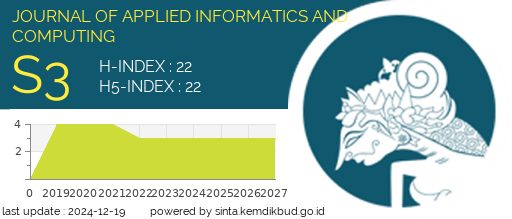Web-Based Makeup Recommendation System Using Hybrid Filtering
DOI:
https://doi.org/10.30871/jaic.v9i3.9339Keywords:
Collaborative Filtering, Content-Based Filtering, Hybrid Filtering, Recommendation System, Weighted HybridAbstract
The increasing use of makeup products in the modern era, driven by evolving beauty trends and e-commerce accessibility, presents challenges in selecting products suited to individual skin types and conditions. A recommendation system addresses this issue by enhancing selection efficiency. This study explores the implementation of Content-Based Filtering (CBF) using TF-IDF and Cosine Similarity, Collaborative Filtering (CF) with Singular Value Decomposition (SVD), and a Hybrid Filtering approach integrating both methods through Weighted Hybrid techniques. The system's performance is evaluated across two user scenarios: new users (without prior ratings) and old users (with rating history). The evaluation method includes Precision, Normalized Discounted Cumulative Gain (NDCG), and accumulation of the best scenario based on user opinion. Results show that Hybrid Filtering outperforms CBF and CF, with notable differences between user groups. For new users, 32% prefer Scenario 1, which emphasizes CBF, achieving 80.8% Precision and 89.73% NDCG. For old users, 23% favor Scenario 2, attaining 83.4% Precision and 90.31% NDCG.
Downloads
References
[1] I. Lisnawati and L. Julaeha, ‘Pengaruh Harga, Kualitas Produk Dan Electronic Word Of Mouth Terhadap Keputusan Pembelian Produk Kosmetik Emina’, Jurnal Ilmiah Multidisiplin, vol. 3, no. 04, pp. 128–136, 2024.
[2] A. O. Lestari and S. Nawangsari, ‘Pengaruh Citra Merek, Kualitas Produk, Keragaman Produk Dan Beauty Vlogger Terhadap Keputusan Pembelian Produk Kosmetik Make Over (Studi Kasus Pada Konsumen Wanita Di Jabodetabek)’, Jurnal Akuntansi dan Manajemen Bisnis, vol. 3, no. 2, pp. 153–166, 2023.
[3] M. Putri, ‘Talk Show: Cara Cerdas Memilih Kosmetik yang Aman’, Edukasi Dan Pengabdian Masyarakat, vol. 1, no. 2, pp. 23–28, 2021.
[4] A. Al Amin, A. Sunyoto, and H. Al Fatta, ‘Mereduksi Error Prediksi Pada Sistem Rekomendasi Menggunakan Pendekatan Collaborative Filtering Berbasis Model Matrix Factorization’, Explore, vol. 11, no. 2, pp. 8–14, 2021.
[5] M. F. Abdurrafi and D. H. U. Ningsih, ‘Content-based filtering using cosine similarity algorithm for alternative selection on training programs’, Journal of Soft Computing Exploration, vol. 4, no. 4, pp. 204–212, 2023.
[6] H. A. Adyatma and Z. K. A. Baizal, ‘Book Recommender System Using Matrix Factorization with Alternating Least Square Method’, Journal of Information System Research (JOSH), vol. 4, no. 4, pp. 1286–1292, 2023.
[7] H. H. Arfisko and A. T. Wibowo, ‘Sistem Rekomendasi Film Menggunakan Metode Hybrid Collaborative Filtering Dan Content-based Filtering’, eProceedings of Engineering, vol. 9, no. 3, 2022.
[8] D. E. Pratama, D. Nurjanah, and H. Nurrahmi, ‘Tourism recommendation system using weighted hybrid method in Bali Island’, Jurnal Media Informatika Budidarma, vol. 7, no. 3, pp. 1189–1199, 2023.
[9] K. S. Y. Putri, I. M. A. D. Suarjaya, and W. O. Vihikan, ‘Sistem Rekomendasi Skincare Menggunakan Metode Content Based Filtering dan Collaborative Filtering’, Decode: Jurnal Pendidikan Teknologi Informasi, vol. 4, no. 3, pp. 764–774, 2024.
[10] C. A. Melyani, ‘Hotel recommendation system with content-based filtering approach (case study: Hotel in yogyakarta on nusatrip website)’, J Statistika: Jurnal Ilmiah Teori dan Aplikasi Statistika, vol. 15, no. 1, 2022.
[11] Y. A. Wibisono, M. Afdal, M. Mustakim, and R. Novita, ‘Implementasi Algoritma Random Forest Untuk Analisa Sentimen Data Ulasan Aplikasi Pinjaman Online Digoogle Play Store’, Building of Informatics, Technology and Science (BITS), vol. 6, no. 2, pp. 619–626, 2024.
[12] R. K. Hapsari, I. Ibadurrohman, and S. R. Wardhana, ‘Sistem Rekomendasi Film dengan Menggunakan Pendekatan Collaborative Filtering Berdasarkan Class’, in Prosiding Seminar Implementasi Teknologi Informasi dan Komunikasi, 2023, pp. 159–164.
[13] F. Ricci, • Lior, R. Bracha, and S. Editors, Recommender Systems Handbook Second Edition. 2015.
[14] A. Pramarta and A. Baizal, ‘Hybrid Recommender System Using Singular Value Decomposition and Support Vector Machine in Bali Tourism’, JIPI (Jurnal Ilmiah Penelitian dan Pembelajaran Informatika), vol. 7, no. 2, pp. 408–418, 2022.
[15] I. Jayaperwira, A. T. Wibowo, and D. Nurjanah, ‘Anime rekomendasi menggunakan Collaborative Filtering’, eProceedings of Engineering, vol. 10, no. 3, 2023.
[16] R. Kusumaningrum and R. Rismiyati, ‘Film Recommender System Menggunakan Metode Neural Collaborative Filtering’, Jurnal Teknologi Informasi dan Ilmu Komputer, vol. 10, no. 3, pp. 699–708, 2023.
[17] R. Cipta and T. R. T. P. Nugraha, ‘Evaluasi Prediksi Curah Hujan dengan Algoritma Backpropogation di BMKG Cilacap’, ZONAsi: Jurnal Sistem Informasi, vol. 2, no. 2, pp. 97–109, 2020.
[18] M. A. Pradana and A. T. Wibowo, ‘Movie recommendation system using hybrid filtering with word2vec and restricted boltzmann machines’, JIPI (Jurnal Ilmiah Penelitian dan Pembelajaran Informatika), vol. 9, no. 1, pp. 231–241, 2024.
[19] D. A. Nugroho, C. Lubis, and N. J. Perdana, ‘Film Recommendation System using Neural Collaborative Filtering Method’, INTECOMS: Journal of Information Technology and Computer Science, vol. 7, no. 3, pp. 926–937, 2024.
Downloads
Published
How to Cite
Issue
Section
License
Copyright (c) 2025 Putu Mia Setya Utami, I Nyoman Prayana Trisna, Wayan Oger Vihikan

This work is licensed under a Creative Commons Attribution-ShareAlike 4.0 International License.
Authors who publish with this journal agree to the following terms:
- Authors retain copyright and grant the journal right of first publication with the work simultaneously licensed under a Creative Commons Attribution License (Attribution-ShareAlike 4.0 International (CC BY-SA 4.0) ) that allows others to share the work with an acknowledgement of the work's authorship and initial publication in this journal.
- Authors are able to enter into separate, additional contractual arrangements for the non-exclusive distribution of the journal's published version of the work (e.g., post it to an institutional repository or publish it in a book), with an acknowledgement of its initial publication in this journal.
- Authors are permitted and encouraged to post their work online (e.g., in institutional repositories or on their website) prior to and during the submission process, as it can lead to productive exchanges, as well as earlier and greater citation of published work (See The Effect of Open Access).











